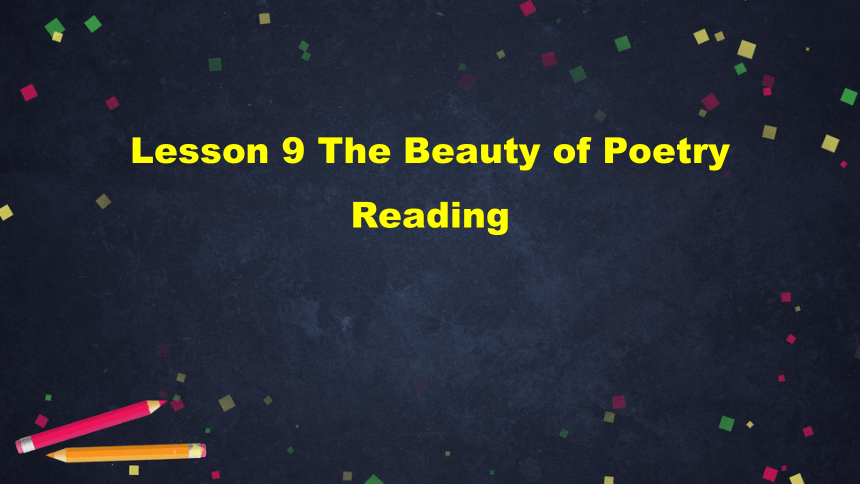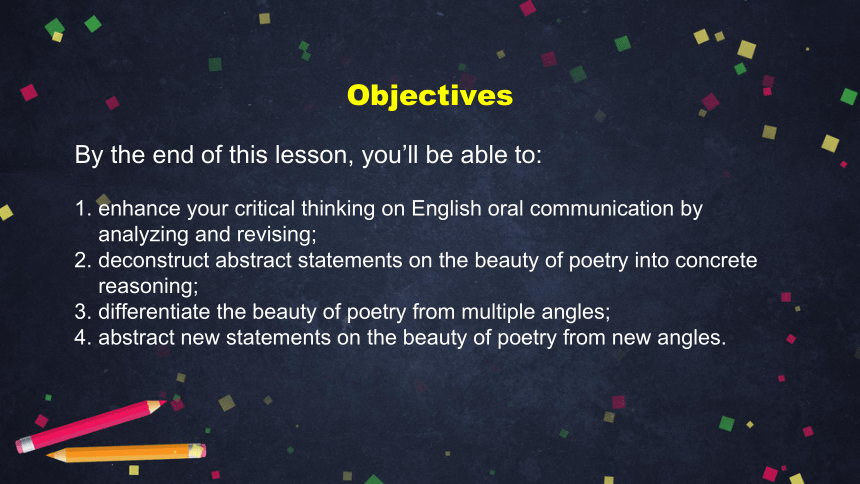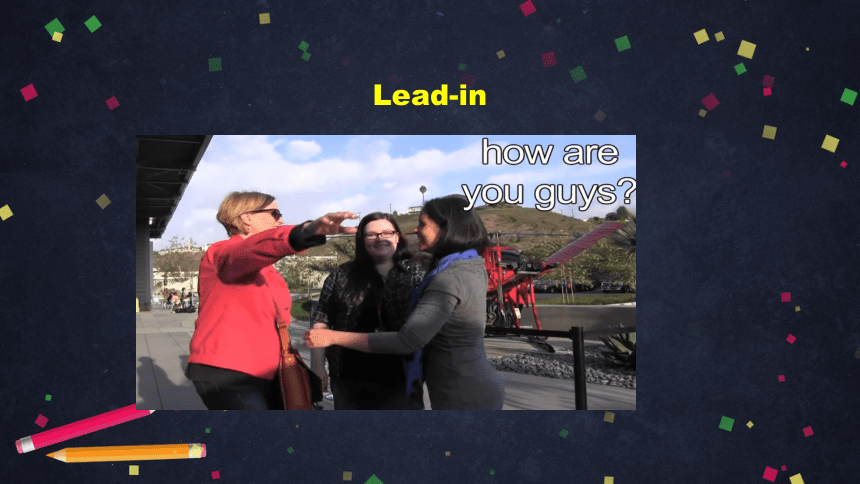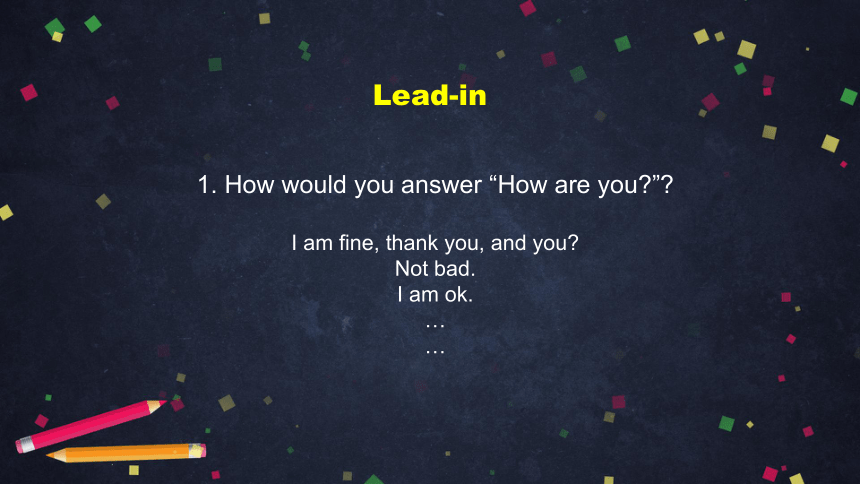高中英语师大版选修六Unit 18 Beauty The Beauty of Poetry reading课件(56张ppt)
文档属性
| 名称 | 高中英语师大版选修六Unit 18 Beauty The Beauty of Poetry reading课件(56张ppt) |

|
|
| 格式 | zip | ||
| 文件大小 | 69.4MB | ||
| 资源类型 | 教案 | ||
| 版本资源 | 北师大版 | ||
| 科目 | 英语 | ||
| 更新时间 | 2020-06-02 16:02:10 | ||
图片预览












文档简介
(共56张PPT)
选修六
Unit
18
Beauty
(9)
高二年级
英语
Lesson
9
The
Beauty
of
Poetry
Reading
Objectives
By
the
end
of
this
lesson,
you’ll
be
able
to:
1.
enhance
your
critical
thinking
on
English
oral
communication
by
analyzing
and
revising;
2.
deconstruct
abstract
statements
on
the
beauty
of
poetry
into
concrete
reasoning;
3.
differentiate
the
beauty
of
poetry
from
multiple
angles;
4.
abstract
new
statements
on
the
beauty
of
poetry
from
new
angles.
Lead-in
Lead-in
Lead-in
Lead-in
Lead-in
1.
How
would
you
answer
“How
are
you?”?
I
am
fine,
thank
you,
and
you?
Not
bad.
I
am
ok.
…
…
Lead-in
Lead-in
2.
Would
you
share
your
emotions
with
the
person
asking?
Probably
not.
Why
is
that?
Lead-in
You
may
think
it
not
appropriate;
it
impolite;
that
there
is
not
enough
time;
that
oral
communication
is
not
for
emotion
sharing.
…
…
Lead-in
&
paragraph
1
Read
paragraph
1
and
underline
the
parts
that
may
answer
this
question.
Is
it
because
humans
are
not
good
at
expressing
their
emotions?
Or
is
it
because
the
person
asking
is
not
really
interested
in
the
answer?
Maybe
it
is
just
that
emotions
are
often
too
personal
or
too
complex
to
be
shared
in
a
casual
conversation.
Lead-in
&
paragraph
1
3.
Do
you
think
all
of
them
are
sound
and
complete
explanations?
Probably
not.
Why?
Lead-in
&
paragraph
1
Read
paragraph
1
again
and
circle
the
words
that
describe
emotions
and
oral
communication.
Lead-in
&
paragraph
1
emotions
oral
communication
private
complex
conditional
situational
…
casual
simple
limited
time
fixed
topics
…
inappropriate
insufficient
Dialectics
of
and
(language)
辩证性
Lead-in
&
paragraph
1
4.
Can
you
revise
(修改)
the
explanations
given
in
the
passage?
It
is
because
emotions
and
simple
oral
communication
are
mutually
repulsive
(排斥的).
The
existence
of
one
can,
more
often
than
not,
be
possible
in
the
absence
of
the
other.
Therefore,
in
situations
such
as
answering
the
“How
are
you?”
question,
people
would
choose
to
suppress
emotions
and
give
a
simple
reply,
like
“Fine”.
Lead-in
&
paragraph
1
5.
But
are
emotions
supposed
to
be
suppressed?
Definitely
not.
6.
Any
solutions
from
this
paragraph?
For
centuries,
people
have
often
expressed
their
emotions
on
paper,
in
the
form
of
poetry.
First
Reading
Read
the
passage
and
choose
one
subtitle
for
each
paragraph.
First
Reading
Solitary
beauty
from
afar
or
accessible
beauty
within
touch?
Subjective
beauty
or
the
clash
of
minds?
A
witness
to
the
vicissitudes
(兴衰沉浮)
of
life.
A
wakening
creator
of
a
new
verse.
A
proper
outlet
of
emotions.
Beauty
or
beauty
in
disguise
(朦胧)?
Para.
5
Para.
4
Para.
3
Para.
6
Para.
1
Para.
2
Second
Reading
Paragraph
2
Beauty
or
beauty
in
disguise
(朦胧)?
Paragraph
2
1.
What
is
the
major
characteristic
of
poetry?
They
silently
inhale
你是夜夜的月圆。
the
clover-scented
gale,
雪化后那片鹅黄,你像;
And
the
vapors
that
arise
新鲜初放芽的绿,你是;
From
the
well-watered
and
smoking
柔嫩喜悦,水光浮动着你梦期待中白莲
soil.
—Rain
in
Summer
--你是人间的四月天
Using
images
or
imagery
(意象)
Paragraph
2
2.
Then
how
does
a
poet
use
imagery?
Can
you
find
some
clues
from
the
example
in
this
paragraph?
Paragraph
2
…
the
poet
describes
the
sail
of
his
friend’s
boat
disappearing
into
the
distance
while
he
watches
the
river
rolling
by.
…
but
by
reading
into
the
poem,
you
can
sense
the
deep
sadness
or
loneliness
that
his
friend’s
leaving
has
caused
him.
scenes
emotions
Paragraph
2
2.
How
does
a
poet
use
imagery?
A
poet
uses
descriptive
(描述性的)
language
to
appeal
to
(感染)
and
evoke
(唤起)
the
readers’
senses
and
imaginations.
感官
see
hear
smell
taste
touch
Paragraph
2
3.
By
using
images,
what
can
a
poet
achieve?
Expressing
emotions
while
maintaining
privacy;
Creating
a
literary
work
of
beauty;
Releasing
emotional
tension.
4.
What
types
of
beauty
is
this
paragraph
discussing?
Paragraph
2
The
beauty
of
the
poets’
spiritual
world
The
beauty
of
the
physical
world
Paragraph
2
5.
What
is
the
subtitle
for
this
paragraph,
can
you
still
remember?
Which
one
best
describes
the
beauty
of
poetry?
Why?
Both.
Because
by
creating
beautiful
images,
poets
set
sceneries
and
emotions
apart,
which
makes
the
beauty
no
longer
cling
to
the
physical
world.
Reading
into
the
poetry,
readers
can
sense
poets’
inner-most
feelings,
which
is
the
beauty
of
poets’
spiritual
world.
Second
Reading
Paragraph
3
A
witness
to
the
vicissitudes
(兴衰沉浮)
of
life.
Paragraph
3
Since
poets
write
to
express
emotions,
then
what
kind?
Any
examples
from
the
text?
positive
emotions
nature
anger
reactions
to
horrific
events
joy,
love
and
happiness
appreciation
of
natural
beauty
the
destruction
of
nature
war
and
death
Paragraph
3
2.
Based
on
this
information,
can
you
exemplify
(列举)
some
types
of
emotions?
Read
this
paragraph
again,
and
fill
in
the
chart
with
clues.
positive
emotions
nature
anger
reactions
to
horrific
events
joy,
love
and
happiness
appreciation
of
natural
beauty
the
destruction
of
nature
war
and
death
Themes
of
poetry
Poets’
view
of
the
world
To
see
the
world
in
a
grain
of
sand
…
…
positive
negative
loving
/hating
appreciative
/depreciative
reactive
/forward-looking
Types
of
emotions
Paragraph
3
3.
The
subtitle
of
this
paragraph
is
a
witness
to
the
vicissitudes
of
life.
Who
can
be
a
witness?
What
are
the
vicissitudes?
A.
The
poetry.
B.
The
poets.
C.
The
readers.
D.
Both
A
and
B.
A.
The
poets’
emotional
reactions.
B.
Human
beings’
inner-world.
C.
The
ups
and
downs
of
the
world.
D.
All
of
the
above.
Second
Reading
Paragraph
4
Subjective
(主观的)
beauty
or
the
clash
of
minds
(思想的冲突)?
Paragraph
4
Daffodils
I
wandered
lonely
as
a
cloud
That
floats
on
high
o'er
vales
and
hills,
When
all
at
once
I
saw
a
crowd,
A
host,
of
golden
daffodils;
Beside
the
lake,
beneath
the
trees,
Fluttering
(飘舞)
and
dancing
in
the
breeze.
Continuous
as
the
stars
that
shine
And
twinkle
on
the
milky
way,
They
stretched
in
never-ending
line
Along
the
margin
(边缘)
of
a
bay:
Ten
thousand
saw
I
at
a
glance,
Tossing
(摇摆)
their
heads
in
sprightly
(愉快地)
dance.
The
waves
beside
them
danced;
but
they
Out-did
the
sparkling
waves
in
glee
(欢喜):
A
poet
could
not
but
be
gay
(愉快的),
In
such
a
jocund
(欢乐的)
company:
I
gazed
—
and
gazed
—
but
little
thought
What
wealth
the
show
to
me
had
brought:
For
oft,
when
on
my
couch
I
lie
In
vacant
(茫然的)
or
in
pensive
(忧伤的)
mood,
They
flash
upon
that
inward
eye
Which
is
the
bliss
of
solitude
(孤独);
And
then
my
heart
with
pleasure
fills,
And
dances
with
the
daffodils.
Paragraph
4
After
experiencing
so
much
beauty
of
daffodils
through
the
poet’s
eyes,
Have
you
got
what
the
poet
intends
to
express?
how
do
you
feel
about
this
poem?
if
you
have
got
some
ideas
about
the
above
questions,
does
it
mean
that
everybody
else
has
the
same
ideas
as
yours?
Paragraph
4
Read
paragraph
4
and
answer
the
following
questions:
1.
What
does
the
author
think
of
Daffodils?
…
I
love
...
I
think
its
a
beautiful
poem
about
…
2.
What
does
the
author’s
English
lecturer
think
of
it?
…
disagreed.
He
thought
that
Wordsworth
was
saying
…
Paragraph
4
3.
Why
do
they
disagree
with
each
other?
Because
poetry
can
be
interpreted
…
different
ways
…
one
person
loves,
another
hates
…
one
person
relates
to
…
may
turn
another
person
off.
Any
reason
else?
Anyone
reading
a
poem
can
have
their
own
view
or
feelings
about
it.
Paragraph
4
4.
From
such
a
phenomenon,
what
should
we
say
about
the
beauty
of
poetry?
The
beauty
of
poetry
is
sub
.
jective
(美是主观的)
Paragraph
4
5.
Other
than
subjective
beauty,
there
is
another
kind
of
beauty
of
poetry
discussed
in
this
paragraph.
Find
it
out
with
further
reading.
Arguing
about
a
poet’s
intention
is
…
Paragraph
4
6.
Why
does
arguing
become
beauty?
Because
they
are
not
always
explicit,
…,
both
…
imagination
and
intellect
are
involved
in
interpreting
the
meaning
behind
the
words.
7.
Since
“arguing”
is
a
kind
of
beauty,
should
we
change
a
name
for
it?
What
should
it
be?
minds
clash
The
of
.
(美是思想的冲突)
Paragraph
4
At
the
beginning
of
this
paragraph,
the
author
mentions
“once
the
words
are
on
paper,
the
poem
takes
on
a
life
of
its
own.
8.
Who
gives
poetry
life?
The
poets.
The
readers.
Emotions/feelings,
ideas,
views.
Imagination,
intellect.
What
is
the
driving
force
of
this
life?
Second
Reading
Paragraph
5
Solitary
beauty
from
afar
or
accessible
beauty
within
touch?
Paragraph
5
Which
kind
of
beauty
best
describes
poetry?
Why?
Accessible
beauty.
Because
poetry
is
not
something
that
is
restricted
to
textbooks
and
classroom
discussions.
Poetry
is
all
around
us
all
the
time.
Paragraph
5
2.
What
audience
group
can
you
infer
from
“textbooks
and
classroom
discussions”?
Why?
Students.
Because
these
words
are
associated
with
students.
3.
Can
you
find
similar
references
that
infer
underlying
audience
groups
in
the
previous
paragraph?
Classrooms
and
lecture
halls.
Paragraph
5
4.
What
audience
group
does
the
author
focus
on
in
this
paragraph?
People
who
seldom
read
poetry.
Your
clue?
“I
never
read
poetry!”
Paragraph
5
5.
But
from
the
author’s
view,
poetry
seems
accessible
to
all
the
people.
What
makes
this
possible?
Why?
Music.
Because
though
some
people
do
not
read
poetry,
almost
all
of
the
people
listen
to
music.
Many
musicians
are
poets
and
they
express
their
emotions
and
views
in
the
lyrics
of
their
songs
using
the
beauty
of
music
to
enhance
the
meaning
of
the
words.
Paragraph
5
6.
Why
music,
rather
than
other
forms
of
art?
What
is
so
distinctive
of
music?
Because
most
music
combines
language
with
melody.
The
melody
can
reach
people’s
heart
more
easily,
and
the
language,
in
the
form
of
lyrics,
is
also
easy
to
understand
and
down-to-earth.
Second
Reading
Paragraph
6
A
wakening
creator
of
a
new
verse.
Paragraph
6
1.
What
is
the
beauty
of
poetry
mentioned
in
this
paragraph?
The
beauty
of
poetry
is
that
it
is
for
everyone
and
anyone
can
write
it.
2.
What
does
everything
in
“everything
inside
you
that
makes
you
human”
refer
to?
Emotions,
feelings
and
ideas.
Paragraph
6
3.
The
subtitle
of
this
paragraph
is
a
wakening
creator
of
a
new
verse.
Who
is
the
creator?
Readers
of
this
passage.
People
in
general.
Paragraph
6
Why
do
we
read
and
write
poetry?
Third
Reading
The
beauty
of
Poetry
Third
Reading
Solitary
beauty
from
afar
or
accessible
beauty
within
touch?
Subjective
beauty
or
the
clash
of
minds?
A
witness
to
the
vicissitudes
(兴衰沉浮)
of
life.
A
wakening
creator
of
a
new
verse.
A
proper
outlet
of
emotions.
Beauty
or
beauty
in
disguise
(朦胧)?
Para.
5
Para.
4
Para.
3
Para.
6
Para.
1
Para.
2
Third
Reading
1.
After
reading
this
passage,
can
you
integrate
the
many
aspects
of
beauty
and
abstract
them
from
new
angles?
hint:
poetry
is
the
creation
of
people
and
the
appreciation
of
people.
Third
Reading
Para.
2
Para.
3
Para.
4
Para.
5
Para.
6
poets
audience
audience
audience
Beauty
is
in
the
eye
of
the
beholder.
Beauty
is
in
the
eye
of
the
creator.
Beauty
is
born
from
the
pen
of
yours.
poets
Beauty
or
beauty
in
disguise?
A
witness
to
the
vicissitudes
(兴衰沉浮)
of
life.
Subjective
beauty
or
the
clash
of
minds?
Solitary
beauty
from
afar
or
accessible
beauty
within
touch?
A
wakening
creator
of
a
new
verse.
Homework
Design
an
oral
presentation
on
the
beauty
of
poetry
based
on
the
newly-abstracted
angles
in
the
third
reading.
选修六
Unit
18
Beauty
(9)
高二年级
英语
Lesson
9
The
Beauty
of
Poetry
Reading
Objectives
By
the
end
of
this
lesson,
you’ll
be
able
to:
1.
enhance
your
critical
thinking
on
English
oral
communication
by
analyzing
and
revising;
2.
deconstruct
abstract
statements
on
the
beauty
of
poetry
into
concrete
reasoning;
3.
differentiate
the
beauty
of
poetry
from
multiple
angles;
4.
abstract
new
statements
on
the
beauty
of
poetry
from
new
angles.
Lead-in
Lead-in
Lead-in
Lead-in
Lead-in
1.
How
would
you
answer
“How
are
you?”?
I
am
fine,
thank
you,
and
you?
Not
bad.
I
am
ok.
…
…
Lead-in
Lead-in
2.
Would
you
share
your
emotions
with
the
person
asking?
Probably
not.
Why
is
that?
Lead-in
You
may
think
it
not
appropriate;
it
impolite;
that
there
is
not
enough
time;
that
oral
communication
is
not
for
emotion
sharing.
…
…
Lead-in
&
paragraph
1
Read
paragraph
1
and
underline
the
parts
that
may
answer
this
question.
Is
it
because
humans
are
not
good
at
expressing
their
emotions?
Or
is
it
because
the
person
asking
is
not
really
interested
in
the
answer?
Maybe
it
is
just
that
emotions
are
often
too
personal
or
too
complex
to
be
shared
in
a
casual
conversation.
Lead-in
&
paragraph
1
3.
Do
you
think
all
of
them
are
sound
and
complete
explanations?
Probably
not.
Why?
Lead-in
&
paragraph
1
Read
paragraph
1
again
and
circle
the
words
that
describe
emotions
and
oral
communication.
Lead-in
&
paragraph
1
emotions
oral
communication
private
complex
conditional
situational
…
casual
simple
limited
time
fixed
topics
…
inappropriate
insufficient
Dialectics
of
and
(language)
辩证性
Lead-in
&
paragraph
1
4.
Can
you
revise
(修改)
the
explanations
given
in
the
passage?
It
is
because
emotions
and
simple
oral
communication
are
mutually
repulsive
(排斥的).
The
existence
of
one
can,
more
often
than
not,
be
possible
in
the
absence
of
the
other.
Therefore,
in
situations
such
as
answering
the
“How
are
you?”
question,
people
would
choose
to
suppress
emotions
and
give
a
simple
reply,
like
“Fine”.
Lead-in
&
paragraph
1
5.
But
are
emotions
supposed
to
be
suppressed?
Definitely
not.
6.
Any
solutions
from
this
paragraph?
For
centuries,
people
have
often
expressed
their
emotions
on
paper,
in
the
form
of
poetry.
First
Reading
Read
the
passage
and
choose
one
subtitle
for
each
paragraph.
First
Reading
Solitary
beauty
from
afar
or
accessible
beauty
within
touch?
Subjective
beauty
or
the
clash
of
minds?
A
witness
to
the
vicissitudes
(兴衰沉浮)
of
life.
A
wakening
creator
of
a
new
verse.
A
proper
outlet
of
emotions.
Beauty
or
beauty
in
disguise
(朦胧)?
Para.
5
Para.
4
Para.
3
Para.
6
Para.
1
Para.
2
Second
Reading
Paragraph
2
Beauty
or
beauty
in
disguise
(朦胧)?
Paragraph
2
1.
What
is
the
major
characteristic
of
poetry?
They
silently
inhale
你是夜夜的月圆。
the
clover-scented
gale,
雪化后那片鹅黄,你像;
And
the
vapors
that
arise
新鲜初放芽的绿,你是;
From
the
well-watered
and
smoking
柔嫩喜悦,水光浮动着你梦期待中白莲
soil.
—Rain
in
Summer
--你是人间的四月天
Using
images
or
imagery
(意象)
Paragraph
2
2.
Then
how
does
a
poet
use
imagery?
Can
you
find
some
clues
from
the
example
in
this
paragraph?
Paragraph
2
…
the
poet
describes
the
sail
of
his
friend’s
boat
disappearing
into
the
distance
while
he
watches
the
river
rolling
by.
…
but
by
reading
into
the
poem,
you
can
sense
the
deep
sadness
or
loneliness
that
his
friend’s
leaving
has
caused
him.
scenes
emotions
Paragraph
2
2.
How
does
a
poet
use
imagery?
A
poet
uses
descriptive
(描述性的)
language
to
appeal
to
(感染)
and
evoke
(唤起)
the
readers’
senses
and
imaginations.
感官
see
hear
smell
taste
touch
Paragraph
2
3.
By
using
images,
what
can
a
poet
achieve?
Expressing
emotions
while
maintaining
privacy;
Creating
a
literary
work
of
beauty;
Releasing
emotional
tension.
4.
What
types
of
beauty
is
this
paragraph
discussing?
Paragraph
2
The
beauty
of
the
poets’
spiritual
world
The
beauty
of
the
physical
world
Paragraph
2
5.
What
is
the
subtitle
for
this
paragraph,
can
you
still
remember?
Which
one
best
describes
the
beauty
of
poetry?
Why?
Both.
Because
by
creating
beautiful
images,
poets
set
sceneries
and
emotions
apart,
which
makes
the
beauty
no
longer
cling
to
the
physical
world.
Reading
into
the
poetry,
readers
can
sense
poets’
inner-most
feelings,
which
is
the
beauty
of
poets’
spiritual
world.
Second
Reading
Paragraph
3
A
witness
to
the
vicissitudes
(兴衰沉浮)
of
life.
Paragraph
3
Since
poets
write
to
express
emotions,
then
what
kind?
Any
examples
from
the
text?
positive
emotions
nature
anger
reactions
to
horrific
events
joy,
love
and
happiness
appreciation
of
natural
beauty
the
destruction
of
nature
war
and
death
Paragraph
3
2.
Based
on
this
information,
can
you
exemplify
(列举)
some
types
of
emotions?
Read
this
paragraph
again,
and
fill
in
the
chart
with
clues.
positive
emotions
nature
anger
reactions
to
horrific
events
joy,
love
and
happiness
appreciation
of
natural
beauty
the
destruction
of
nature
war
and
death
Themes
of
poetry
Poets’
view
of
the
world
To
see
the
world
in
a
grain
of
sand
…
…
positive
negative
loving
/hating
appreciative
/depreciative
reactive
/forward-looking
Types
of
emotions
Paragraph
3
3.
The
subtitle
of
this
paragraph
is
a
witness
to
the
vicissitudes
of
life.
Who
can
be
a
witness?
What
are
the
vicissitudes?
A.
The
poetry.
B.
The
poets.
C.
The
readers.
D.
Both
A
and
B.
A.
The
poets’
emotional
reactions.
B.
Human
beings’
inner-world.
C.
The
ups
and
downs
of
the
world.
D.
All
of
the
above.
Second
Reading
Paragraph
4
Subjective
(主观的)
beauty
or
the
clash
of
minds
(思想的冲突)?
Paragraph
4
Daffodils
I
wandered
lonely
as
a
cloud
That
floats
on
high
o'er
vales
and
hills,
When
all
at
once
I
saw
a
crowd,
A
host,
of
golden
daffodils;
Beside
the
lake,
beneath
the
trees,
Fluttering
(飘舞)
and
dancing
in
the
breeze.
Continuous
as
the
stars
that
shine
And
twinkle
on
the
milky
way,
They
stretched
in
never-ending
line
Along
the
margin
(边缘)
of
a
bay:
Ten
thousand
saw
I
at
a
glance,
Tossing
(摇摆)
their
heads
in
sprightly
(愉快地)
dance.
The
waves
beside
them
danced;
but
they
Out-did
the
sparkling
waves
in
glee
(欢喜):
A
poet
could
not
but
be
gay
(愉快的),
In
such
a
jocund
(欢乐的)
company:
I
gazed
—
and
gazed
—
but
little
thought
What
wealth
the
show
to
me
had
brought:
For
oft,
when
on
my
couch
I
lie
In
vacant
(茫然的)
or
in
pensive
(忧伤的)
mood,
They
flash
upon
that
inward
eye
Which
is
the
bliss
of
solitude
(孤独);
And
then
my
heart
with
pleasure
fills,
And
dances
with
the
daffodils.
Paragraph
4
After
experiencing
so
much
beauty
of
daffodils
through
the
poet’s
eyes,
Have
you
got
what
the
poet
intends
to
express?
how
do
you
feel
about
this
poem?
if
you
have
got
some
ideas
about
the
above
questions,
does
it
mean
that
everybody
else
has
the
same
ideas
as
yours?
Paragraph
4
Read
paragraph
4
and
answer
the
following
questions:
1.
What
does
the
author
think
of
Daffodils?
…
I
love
...
I
think
its
a
beautiful
poem
about
…
2.
What
does
the
author’s
English
lecturer
think
of
it?
…
disagreed.
He
thought
that
Wordsworth
was
saying
…
Paragraph
4
3.
Why
do
they
disagree
with
each
other?
Because
poetry
can
be
interpreted
…
different
ways
…
one
person
loves,
another
hates
…
one
person
relates
to
…
may
turn
another
person
off.
Any
reason
else?
Anyone
reading
a
poem
can
have
their
own
view
or
feelings
about
it.
Paragraph
4
4.
From
such
a
phenomenon,
what
should
we
say
about
the
beauty
of
poetry?
The
beauty
of
poetry
is
sub
.
jective
(美是主观的)
Paragraph
4
5.
Other
than
subjective
beauty,
there
is
another
kind
of
beauty
of
poetry
discussed
in
this
paragraph.
Find
it
out
with
further
reading.
Arguing
about
a
poet’s
intention
is
…
Paragraph
4
6.
Why
does
arguing
become
beauty?
Because
they
are
not
always
explicit,
…,
both
…
imagination
and
intellect
are
involved
in
interpreting
the
meaning
behind
the
words.
7.
Since
“arguing”
is
a
kind
of
beauty,
should
we
change
a
name
for
it?
What
should
it
be?
minds
clash
The
of
.
(美是思想的冲突)
Paragraph
4
At
the
beginning
of
this
paragraph,
the
author
mentions
“once
the
words
are
on
paper,
the
poem
takes
on
a
life
of
its
own.
8.
Who
gives
poetry
life?
The
poets.
The
readers.
Emotions/feelings,
ideas,
views.
Imagination,
intellect.
What
is
the
driving
force
of
this
life?
Second
Reading
Paragraph
5
Solitary
beauty
from
afar
or
accessible
beauty
within
touch?
Paragraph
5
Which
kind
of
beauty
best
describes
poetry?
Why?
Accessible
beauty.
Because
poetry
is
not
something
that
is
restricted
to
textbooks
and
classroom
discussions.
Poetry
is
all
around
us
all
the
time.
Paragraph
5
2.
What
audience
group
can
you
infer
from
“textbooks
and
classroom
discussions”?
Why?
Students.
Because
these
words
are
associated
with
students.
3.
Can
you
find
similar
references
that
infer
underlying
audience
groups
in
the
previous
paragraph?
Classrooms
and
lecture
halls.
Paragraph
5
4.
What
audience
group
does
the
author
focus
on
in
this
paragraph?
People
who
seldom
read
poetry.
Your
clue?
“I
never
read
poetry!”
Paragraph
5
5.
But
from
the
author’s
view,
poetry
seems
accessible
to
all
the
people.
What
makes
this
possible?
Why?
Music.
Because
though
some
people
do
not
read
poetry,
almost
all
of
the
people
listen
to
music.
Many
musicians
are
poets
and
they
express
their
emotions
and
views
in
the
lyrics
of
their
songs
using
the
beauty
of
music
to
enhance
the
meaning
of
the
words.
Paragraph
5
6.
Why
music,
rather
than
other
forms
of
art?
What
is
so
distinctive
of
music?
Because
most
music
combines
language
with
melody.
The
melody
can
reach
people’s
heart
more
easily,
and
the
language,
in
the
form
of
lyrics,
is
also
easy
to
understand
and
down-to-earth.
Second
Reading
Paragraph
6
A
wakening
creator
of
a
new
verse.
Paragraph
6
1.
What
is
the
beauty
of
poetry
mentioned
in
this
paragraph?
The
beauty
of
poetry
is
that
it
is
for
everyone
and
anyone
can
write
it.
2.
What
does
everything
in
“everything
inside
you
that
makes
you
human”
refer
to?
Emotions,
feelings
and
ideas.
Paragraph
6
3.
The
subtitle
of
this
paragraph
is
a
wakening
creator
of
a
new
verse.
Who
is
the
creator?
Readers
of
this
passage.
People
in
general.
Paragraph
6
Why
do
we
read
and
write
poetry?
Third
Reading
The
beauty
of
Poetry
Third
Reading
Solitary
beauty
from
afar
or
accessible
beauty
within
touch?
Subjective
beauty
or
the
clash
of
minds?
A
witness
to
the
vicissitudes
(兴衰沉浮)
of
life.
A
wakening
creator
of
a
new
verse.
A
proper
outlet
of
emotions.
Beauty
or
beauty
in
disguise
(朦胧)?
Para.
5
Para.
4
Para.
3
Para.
6
Para.
1
Para.
2
Third
Reading
1.
After
reading
this
passage,
can
you
integrate
the
many
aspects
of
beauty
and
abstract
them
from
new
angles?
hint:
poetry
is
the
creation
of
people
and
the
appreciation
of
people.
Third
Reading
Para.
2
Para.
3
Para.
4
Para.
5
Para.
6
poets
audience
audience
audience
Beauty
is
in
the
eye
of
the
beholder.
Beauty
is
in
the
eye
of
the
creator.
Beauty
is
born
from
the
pen
of
yours.
poets
Beauty
or
beauty
in
disguise?
A
witness
to
the
vicissitudes
(兴衰沉浮)
of
life.
Subjective
beauty
or
the
clash
of
minds?
Solitary
beauty
from
afar
or
accessible
beauty
within
touch?
A
wakening
creator
of
a
new
verse.
Homework
Design
an
oral
presentation
on
the
beauty
of
poetry
based
on
the
newly-abstracted
angles
in
the
third
reading.
